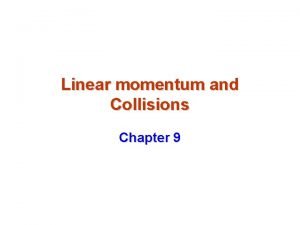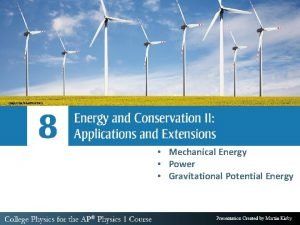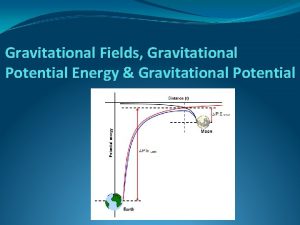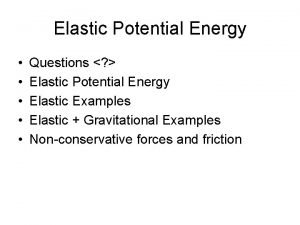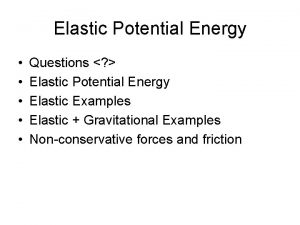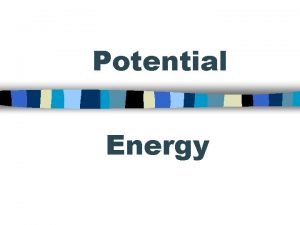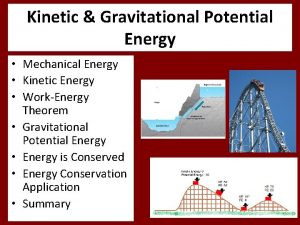Equations Gravitational potential energy Elastic potential energy Kinetic









- Slides: 9

Equations: Gravitational potential energy Elastic potential energy Kinetic energy Work done Power Specific heat capacity Energy efficiency Lessons: Potential energy Investigating kinetic energy Work done and energy transfer Understanding power Specific heat capacity Dissipation of energy Energy efficiency Using energy resources Global energy supplies Infra-Red Radiation & GW P 1: Energy Required Practicals: Investigating specific heat capacity Use theories to develop a hypothesis Evaluate a method and suggest improvements Perform calculations to support conclusions Investigating ways of reducing the unwanted energy transfers in a system Use scientific ideas to make a prediction Analyse data to identify trends Evaluate an experimental procedure Key words: Elastic potential energy Gravitational field strength Energy store Kinetic energy Force Work Power Specific heat capacity Energy transferred Conduction Energy dissipation Radiation Thermal conductivity Conservation of energy Energy efficiency Insulation Non-renewable resource Renewable resource Blackbody Radiation Absorption and emmission

Equations: charge flow potential difference power resistance energy transferred Lessons: Static Charges Electric current Series and parallel circuits Investigating circuits Circuit components Control circuits Electricity in the home Transmitting electricity Power and energy transfers Calculating power Key concept: What’s the difference between potential difference and current? P 2: Electricity Required Practicals: Required practical: Investigate, using circuit diagrams to construct circuits, the I–V characteristics of a filament lamp, a diode and a resistor at constant temperature Understand how an experiment can be designed to test an idea Evaluate how an experimental procedure can yield more accurate data Interpret and explain graphs using scientific ideas Required practical: Use circuit diagrams to set up and check appropriate circuits to investigate the factors affecting the resistance of electrical circuits, including the length of a wire at constant temperature and combinations of resistors in series and parallel Use a circuit to determine resistance Gather valid data to use in calculations Apply the circuit to determine the resistance of combinations of components Key words: electron coulomb parallel potential difference resistance voltmeter parallel circuit series circuit ammeter equivalent resistance filament bulb dependent variable independent variable ohmic conductor current series diode light-dependent resistor (LDR) sensors thermistor earth fuse live neutral National Grid transformer power

Equations: Density Change in thermal energy Latent Heat (energy for a change of state) Boyles Law (Pressure-Volume) P 3: Particle model of matter Required Practicals: Lessons: Density Changes of State Internal Energy Specific Heat Capacity Latent Heat Particle Motion in Gases Gas Pressure and Temperature Gas Pressure and Volume Key Concept: Particle Theory and Changes of State To investigate the densities of regular and irregular solid objects and liquids Interpret observations and data Use spatial models to solve problems Plan experiments and devise procedures Use an appropriate number of significant figures in measurement and calculations Key words: bonds density gas liquid particle model solid significant figures resolution boil changes of state condense conservation of mass freeze melt sublimate internal energy specific heat capacity latent heat specific latent heat of fusion specific latent heat of vaporisation gas pressure randomly fusion matter vaporisation line or curve of best fit range scale

Equations: None P 4: Atomic Structure Required Practicals: None Lessons: Atomic structure Radioactive decay Nuclear equations Radioactive half-life Hazards and uses of radiation Irradiation Nuclear Radiation in Medicine Nuclear Fission Nuclear Fusion Key concept: Developing ideas for the structure of the atom Key words: atomic number energy level ionise isotope mass number nucleon activity alpha particle becquerel (Bq) beta particle gamma ray neutron radiation nuclear radiation radioisotope random alpha decay beta decay nuclear equation half-life hazard radioactive contamination tracer irradiation mutation peer review atom electron neutron nuclear model nucleus plum pudding model proton ratio fission fusion

Equations: Speed Average speed Acceleration Uniform motion Weight Resultant force Work done Velocity Pressure (solid) Pressure (fluid) Moment Extension Lessons: Forces Speed Acceleration Velocity-time graphs Calculations of motion Heavy or massive? Forces and motion Resultant forces Forces and acceleration Newton’s third law Momentum Keeping safe on the road Forces and energy in springs Momentum, Conservation of Momentum and Safety Forces and Pressure Key concept: Forces and acceleration P 5: Forces Required Practicals: Required practical: Investigating the acceleration of an object Plan an investigation to explore an idea. Analyse results to identify patterns and draw conclusions. Compare results with scientific theory. Required practical: Investigate the relationship between force and the extension of a spring Interpret readings to show patterns and trends. Interpret graphs to form conclusions. Apply the equation for a straight line to the graph. Key words: direct proportion inverse proportion Newton’s third law contact force displacement newtons (N) conservation of momentum crumple zones non-contact force momentum scalar rate of change vector braking distance velocity reaction time average speed stopping distance-time graph thinking distance gradient compression speed elastic deformation tangent acceleration elastic potential energy extension air resistance ( or drag) inelastic deformation deceleration displacement limit of proportionality linear rate of change non-linear sketch graph spring constant velocity-time graph anomaly uniform motion mean gravitational field strength velocity mass estimate newtonmeter order of magnitude weight round balanced forces density equilibrium upthrust Newton’s first law resultant force balanced forces components of a force free-body diagram resultant force resolving a force unbalanced forces gravitational mass inertial mass Newton’s second law

Equations: Wave speed Speed Magnification Lessons: Describing waves Transverse and longitudinal waves Key concept: Transferring energy or information by waves Measuring wave speeds Reflection and refraction of waves The electromagnetic spectrum Reflection, refraction and wave fronts Gamma rays and X-rays Ultraviolet and infrared radiation Microwaves Radio and microwave communication Sound Ultrasound Seismic Waves P 6: Waves Required Practicals: Required practical: Measuring the wavelength, frequency and speed of waves in a ripple tank and waves in a solid Develop techniques for making observations of waves. Select suitable apparatus to measure frequency and wavelength. Use data to answer questions. Required practical: Investigate how the amount of infrared radiation absorbed or radiated by a surface depends on the nature of that surface Explain reasons for the equipment used to carry out an investigation. Explain the rationale for carrying out an investigation. Apply ideas from an investigation to a range of practical contexts. Key words: amplitude frequency hertz time period wavelength compression longitudinal wave rarefaction transverse wave absorb amplitude energy transfer vibration echo sounding speed absorption normal ray diagram reflection refraction transmission electromagnetic waves electromagnetic spectrum longitudinal wave transverse wave visible spectrum wavefront gamma ray radiation dose tracer X-ray infrared radiation ultraviolet radiation emission radiation microwaves radio waves receiver satellite transmitter proportional pitch high-frequency sound s-waves p-waves s-wave shadow loudness

Equations: reflection refraction magnification P 6 a: Light Required Practicals: Light Experiments Lessons: Reflection Refraction Colour Lenses Ray Diagrams Key words: normal angle of incidence angle of refraction virtual image specular reflection diffuse reflection refraction angle of refraction boundary prism light colour opaque transparent translucent absorption wavelength convex lens concave lens converging lens diverging lens principle focus principle axis magnifying glass focal lens real image magnification image height object height ray diagrams

Equations: Force on a conductor in a magnetic field Transformer Turns P 7: Electromagnetism Required Practicals: None Lessons: Magnetism and magnetic forces Compasses and magnetic fields The magnetic effect of a solenoid Electromagnetism and its uses Calculating the force on a conductor Electric motors Generators Transformers Key concept: The link between electricity and magnetism Key words: attract induced magnetic field permanent magnet poles repel Earth’s magnetic field Flemming’s left-hand rule motor effect solenoid magnetic flux density tesla (T) split-ring commutator induced potential difference electromagnet temporary magnet iron core ring commutator induced magnetic field

Equations: NONE P 8: Space Required Practicals: None Lessons: Formation of the Solar System Life cycle of a Star Planets, satellites and orbits Expanding Universe Big Bang Future Universe Key words: protostar main sequence gas/dust clouds gravitational attraction stable star solar system red giant white dwarf black dwarf red supergiant supernova elements fusion neutron star black hole circular orbits artificial satellites communication satellites gravity geostationary satellites polar satellites Hubble red-shift light spectra cosmic microwave background radiation (CMBR) big bang dark matter big yawn big crunch
 Kinetic energy in gravitation
Kinetic energy in gravitation Gravitational potential energy vs kinetic energy
Gravitational potential energy vs kinetic energy Potential energy spring
Potential energy spring What is the formula for elastic collision
What is the formula for elastic collision Kinetic and potential energy
Kinetic and potential energy Elastic potential energy examples
Elastic potential energy examples Conservation of mechanical energy
Conservation of mechanical energy Kinetic energy and potential energy formula
Kinetic energy and potential energy formula Formula of potential energy
Formula of potential energy Gravitational potential energy formula between two objects
Gravitational potential energy formula between two objects



